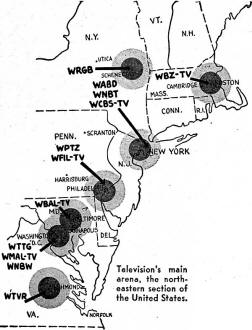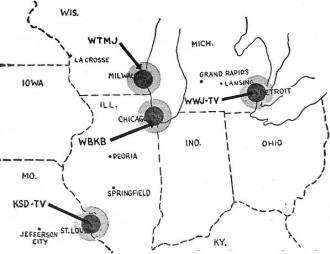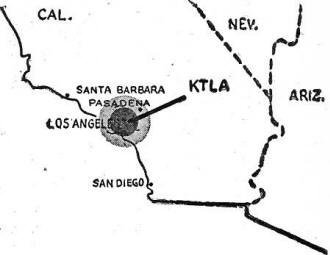|
January 1948 Radio-Craft
 [Table of Contents] [Table of Contents]
Wax nostalgic about and learn from the history of early electronics.
See articles from Radio-Craft,
published 1929 - 1953. All copyrights are hereby acknowledged.
|
Most of us have heard of the
National Association of Broadcasters
(NAB). Founded in 1922 at the dawn of commercial radio broadcasting, it is still
in existence today. When commercial television broadcasting "stepped out" in a major
way in the early 1940s, industry chieftains and station owners decided that their
new media paradigm was unique enough to warrant a separate union, so the Television
Broadcasters Association (TBA) was formed. A lot of effort went into establishing
and building a coalition with enough influence in the marketplace and with government
regulators, independent of radio, to exist as a force to be dealt with. Many people
believed that radio as an entertainment and news media source would decrease at
a rate as great or greater than television was increasing. Once again, experts were
not successful at predicting behavior of the citizenry, which was true both in the
United States and around the world. An in-depth case study of the ordeal entitled,
The Rise and Fall of the Television Broadcasters
Association, 1943–1951, was published by Boston University's
Deborah
L. Jaramillo.
Television Steps Out!

Graphic comparison of radio and television.

Television's main arena, the northeastern section of the United
States.
The new art is repeating the history of broadcasting on a grander scale.
By Will Baltin*
Television's tremendous potential, which has been pent up for so many years,
will burst forth across the United States this year with force that will rock the
inertia and indifference out of a lot of people. Television talk has been bantered
about for so long that it is little wonder that millions, of Americans living in
the vast hinterlands, who have yet to see a television image sweep across the face
of a cathode-ray tube, still accept this new art with the proverbial grain of salt.
Twenty-six years ago when radio broadcasting began to enlist adherents through
the magic of a cat's whisker, a crystal, and a pair of headphones, a skeptical public
was equally disbelieving. Only after the doubter got a "dose of listening" did he
fully realize that a new wonder had been achieved for him to own and enjoy.
Television is finally breaking out of its shell and is now on its way to becoming
a principal service. With nearly 150,000 television receivers in the hands of the
public as 1947 faded into oblivion, television had at long last ceased to be an
experimenter's delight. It is now a commercial product with enormous un-tapped possibilities.
A recent survey made by the Television Broadcasters Association, Inc., indicated
that in 1922, radio's first big year, there were 100,000 radio receivers in use
in the United States. In 1947, a comparable year for television, 150,000 television
sets were in use. In 1923 there were about 550,000 radio sets in homes and public
places. The estimate for television this year runs well over 750,000 receivers.
In dollar volume, the comparison between radio yesteryear and television today
lifts the eyebrow high on the dome. For example: the dollar volume in radio receivers
at retail levels in 1922 approximated $5,000,000. The dollar volume in television
at the same levels last year amounted to a staggering $74,000,000! In 1923 radio's
dollar volume totaled $30,000,000. In television, the estimate for this year exceeds
$387,000,000!
Hence, the strides made by television to date are already far ahead,
comparatively, of radio, presaging a popular future for this newest of
twentieth-century miracles.
Television brings into the home a veritable potpourri of entertainment,
information, culture, and education. Ask any man who owns a television set. The
effect of televiewing on the present army of set owners parallels - and surpasses
- the enthusiasm of the early radiophone DXers.
The mere fact that television receivers will be abundantly available this year
does not tell the whole story of the impending expansion. Unless television stations
are operating, the market for receivers is negligible. No one knows this better
than television industry leaders - and there are several factors at work to ensure
their operation.
These include new station operators, network planners, and the Federal Communications
Commission. At the close of the year, the FCC had granted nearly 75 construction
permits for new television stations in 25 states. Service currently available in
New York State, New Jersey, Connecticut, Pennsylvania, Delaware, Maryland, District
of Columbia, Illinois, Michigan, Missouri, Wisconsin, and California soon will be
expanded to include Massachusetts, Ohio, Virginia, Florida, Texas, Louisiana, Indiana,
New Mexico, Oregon, Utah, Rhode Island, the State of Washington, and in many other
sections of the United States.

Four stations in the Midwest are the nucleus of a Central United
States group of television stations which will be increased very soon.

This station, plus experimental transmissions from W6XAO, represents
Pacific Coast television.
It is estimated that between 35 and 40 television stations will be operating
in at least 18 states by the end of 1948 and that an additional 35 will be in full
operation within the following year. Not all cities in the states listed will have
television service immediately. Areas with the heaviest concentration of population
will come first within the range of video stations; other areas will obtain this
service subsequently.
To bring the best in television entertainment to multitudes living away from
urban centers, network planners are now plowing into the ground thousands of miles
of concentric or coaxial cable capable of carrying televised images from coast to
coast and making possible networks similar to those that have been spun by radio
stations into a gigantic web. Television images bound on highly directional microwaves
over a series of towers from New York to Boston. Later they will be sent from New
York to Chicago - and beyond.
The Federal Communications Commission has hitched its wagon to the star of television
expansion and is cooperating with broadcasters to develop this potentially gigantic
service. With such a cooperative effort in full swing, there is no doubt that 1948
looms big for television.
Although home television is the vogue, there is feverish behind-the-scenes activity
in the motion picture industry to introduce theater-size television at your favorite
movie house. In the East and Far West, it may happen early this year.
The revolution that marked the end of the silent era of movies undoubtedly will
appear insignificant to the advances in entertainment which theater-type television
will bring to the screen of the average movie house.
The march of television progress has begun; it cannot be halted; it will not
be stymied. Television is here!
*Executive Secretary-Treasurer, Television Broadcasters Association, Inc.
Posted December 17, 2019
|













